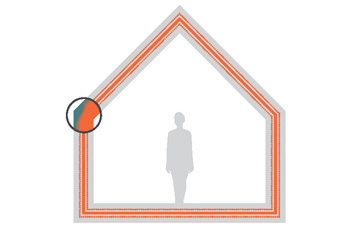Components

Advanced Building Envelope
The conservation-first approach to high performance building starts with the advanced building envelope. Guided by physics and building science, advanced building envelopes combine a simple suite of components to manage heat, air, and moisture and deliver superior efficiency, durability, comfort, and occupant health.
The first step is airtight construction. By controlling the movement of air across building assemblies we also control the movement of heat and moisture. To this end, we wrap a continuous, unbroken air barrier around our high performance buildings.
Next we super-insulate, combining a thick layer of interior insulation in wall cavities with a continuous, “monolithic,” layer of exterior insulation to thermally isolate the envelope and to keep sheathing warm and free of condensation.
We also detail carefully to “break” the thermal bridges that can compromise a building’s thermal layer and rob it of efficiency and comfort. These insulation-bypassing flaws in building design can also undermine durability by introducing condensation-causing cold penetrations into otherwise warm layers of an assembly.
To protect the envelope from bulk water intrusion we install a water-resistant barrier, or WRB. Often, though not always, this WRB also serves as the building’s air barrier. The WRB should not be confused with a vapor barrier. In our maritime Pacific NW climate we tend to avoid vapor barriers in our wall assemblies and therefore employ vapor-open WRBs in our assemblies. Because vapor drive can oscillate between inside-to-outside and outside-to-inside numerous times in a single day in our climate, we like to detail our walls to be vapor open in both directions to facilitate drying.
To further promote this drying capacity, high performance buildings employ a ventilated rain screen, a gap between cladding and wall assembly that not only provides a channel for bulk water to drain away, but also generates air movement across the face of the assembly to dramatically increase drying. All things equal, a highly thermally resistant wall will have less drying capacity than a conventional wall, so the air movement provided by the ventilated rain screen helps ensure the resilience and durability of high performance wall assemblies.
As a holistic system, the advance building envelope transforms building energy efficiency with its airtight and thermally resistant layers, promotes occupant comfort by creating even, warm interior surface temperatures, and ensures building durability and occupant health by minimizing the risk of the moisture accumulations that lead to rot and mold.

Example of Passive House Wall Assembly